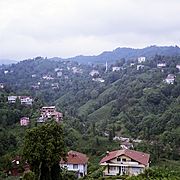Rize tea facts for kids
 |
|
| Type: | Black |
|
|
|
| Other names: | Rize çayı, Çay |
| Origin: | Rize Province, Turkey |
|
|
|
| Quick description: | Turkish tea produced in the eastern Black Sea province of Rize |
|
|
|
Rize tea, also known as Rize çayı, is a special type of black tea. It's the main tea used to make Turkish tea. This tea comes from the Rize Province in Turkey. The Rize area has a mild climate with lots of rain and rich soil. When you brew Rize tea, it turns a beautiful reddish-brown color, like mahogany wood.
People drink Rize tea at home and in Turkish cafés. In cafés, a person called a çaycı (say "chai-jee") serves it. They pour the tea into small, thin glasses that are narrow in the middle. You can choose your tea to be strong, which is called demli (dark), or weak, which is called açık (light). Traditionally, people add sugar crystals (toz şeker) or sugar cubes (kesme şeker) to their tea.
Where Does Rize Tea Come From?
The Rize Province is located between the Pontic Mountains and the Black Sea. It's known as one of the wettest places in Turkey. This wet and mild environment is perfect for growing tea plants. The land has many mountain valleys, which makes it a great place for different kinds of plants and animals to live.
How Tea Growing Started in Rize
People first tried growing tea in the Rize Province in 1912. This idea came from Hulusi Bey, who was in charge of the Chamber of Agriculture. But it took many years for the tea farms to grow a lot of tea. By around 1945, the tea plantations in Rize were finally producing large amounts of tea.
Rize Province is one of the biggest and most successful tea-growing areas in Turkey. In 1947, the first tea factory was built in the region. Then, in 1958, a special research center for tea was created in Rize. This helped farmers learn even more about growing the best tea.
People Who Harvest Rize Tea
Growing tea in Rize brought many good changes to the area. It created jobs and helped the region become richer. Before, it was a poorer area. Many people moved there for work.
Today, people who harvest Rize tea often come from other countries. Many migrant workers come from Georgia and Azerbaijan. In 2021, about 40,000 foreign workers were expected for the harvest season. However, due to travel rules during the COVID-19 pandemic, workers from African countries like Gambia, Senegal, Sudan, and Zambia came to help instead.



